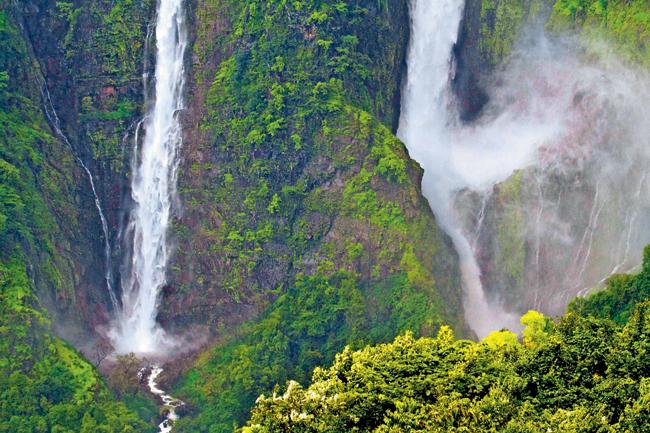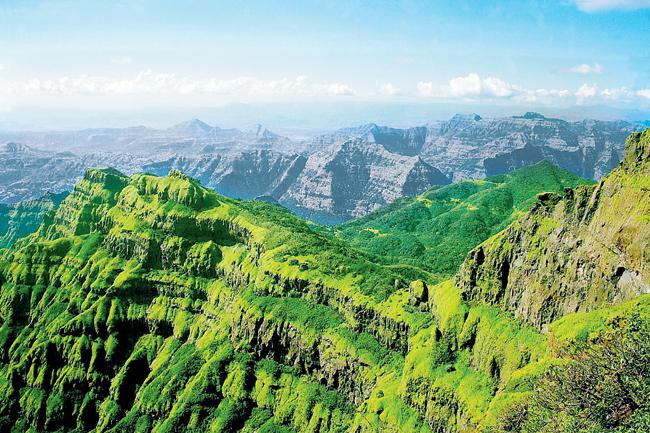Filmmaker Arti Kulkarni's documentary, Nata Pashchim Ghatashi, takes the viewer on a journey through the Western Ghats, to focus on how development is destroying this green belt

The Western Ghats, a UNESCO World Heritage Site, is considered one among the eight hotspots for biodiversity in the world. It is also, however, plagued by issues, including illegal mining, which has wreaked havoc in the region. Drawing attention to it is the 56-minute Marathi documentary, Nata Pashchim Ghatashi (translates into ‘a relationship with the Western Ghats’). In the news for having won awards at the Vasundhara International Film Festival and the Vatavaran Environment and Wildlife Film Festival, it was screened last week at the Bombay Natural History Society.
 The base of Vanzra Falls in Goa, a niche eco-system that is nurtured by the spray of these falls. Pic Courtesy/ team wildernest
The base of Vanzra Falls in Goa, a niche eco-system that is nurtured by the spray of these falls. Pic Courtesy/ team wildernest
ADVERTISEMENT
It is directed and narrated in Marathi by 36-year-old Arti Kulkarni, a broadcast journalist with a TV news channel, who took a sabbatical to shoot the documentary. Her work took her to six states — Gujarat, Maharashtra, Goa, Karnataka, Tamil Nadu and Kerala. Kulkarni reflects on the project, “It was very topical as the Western Ghats were recently declared as a World Heritage Site (in 2012). Going back in time, it’s been 25 years since the Save the Western Ghats march (padyatra) in 1987-88 drew attention to the region.”

A view of the Western Ghats. pic courtesy/ Isaac kehimkar
Alarm bells
She adds that as a journalist who covered environmental issues, she was alarmed by the fact that the area, which is rich in natural resources, was being steadily destroyed. She visited a few spots in the Western Ghats for a reality check, which led to the documentary. Kulkarni took nearly nine months (from February to November, 2013) to complete the film and was clear from the start that it would be a non-commercial film.

Arti Kulkarni (extreme right) with environmentalists and forest officials
The issues highlighted include illegal sand mining in Gujarat and Goa; setting up of windmills in Maharashtra and hydroelectric plants in Kerala. “A documentary seemed the most effective way to put forward the message of conservation. The idea was to cover the regions during the three seasons of winter, summer and rainfall. In every region, we had a resource person ranging from forest officials to environmentalists, locals and activists who guided us and voiced their opinions and worries on camera,” she informs. Kulkarni worked on a shoestring budget and pooled in her award money of '2 lakh towards financing the film. With the eventual cost of filming at '7 lakh, she is still scouring for funds.

Great Pied Hornbill is found in the region
Challenging terrain
She worked with just 3-4 people including two camerapersons and a driver. The major challenges, she recounts, were the funding and the travel logistics: “I started my journey from northern Maharashtra, headed to Gujarat and returned to Maharashtra as the Western Ghats crisscross state limits.”
Kulkarni admits that she ensured the documentary presented a comprehensive and balanced view of the region. She consciously chose to focus on unexplored places and gave the common tourist areas a miss. “I wanted to explore newer eco-systems, so the film showcases dams and rainforests in Karnataka, Kerala’s jungles, and the birds, insects and plants found in the Western Ghats. Of all the places we visited, Goa was the best and the worst (in terms of destruction). It is the heart of the Western Ghats. With 70% of the biodiversity destroyed (in Goa), how can we expect regeneration?” she rues.
While the Western Ghats span 1,600 km, Kulkarni covered 1,000 km for the shoot. “In the film, I have narrated our journey as we went from place to place, so that the viewer feels a part of the process. I wanted to bring these grassroot issues to the mainstream. Being the origin of rivers like Krishna, Kaveri and Godavari, the Western Ghats are a life source and yet few are aware of its significance,” she reminds.
Did you know?
>> Thirty-nine locations of the Western Ghats have been declared as World Natural Heritage sites by UNESCO.
>> There are 5,000 species of plants, 137 species of mammals, 508 species of birds and 181 species of amphibians in the Western Ghats.
>> According to the World Wide Fund for Nature (WWF), there are 200 globally threatened species in the Western Ghats, but only 10 per cent of the Western Ghats comes under protected category.
 Subscribe today by clicking the link and stay updated with the latest news!" Click here!
Subscribe today by clicking the link and stay updated with the latest news!" Click here!







